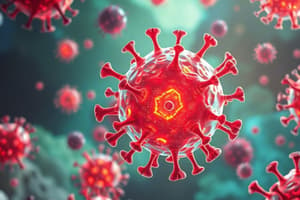Podcast
Questions and Answers
What characteristic makes viruses challenging to classify as living organisms?
What characteristic makes viruses challenging to classify as living organisms?
- They possess both DNA and RNA
- They have complex cellular structures
- They reproduce independently
- They are non-cellular and obligate parasites (correct)
Which of the following best describes an antigen?
Which of the following best describes an antigen?
- A cell type involved in viral replication
- A symptom of viral infections
- A foreign substance triggering antibody production (correct)
- A type of surface protein found on viruses
What is the correct sequence of stages in viral replication?
What is the correct sequence of stages in viral replication?
- Entry, Assembly, Synthesis, Attachment, Release
- Attachment, Synthesis, Assembly, Entry, Release
- Assembly, Release, Attachment, Entry, Synthesis
- Attachment, Entry, Synthesis, Assembly, Release (correct)
Which of the following human diseases is caused by a virus?
Which of the following human diseases is caused by a virus?
What is one potential benefit of viruses?
What is one potential benefit of viruses?
Flashcards are hidden until you start studying
Study Notes
Classification of Viruses
- Viruses are challenging to classify as living entities due to their non-cellular structure.
- They are obligate parasites, relying on host cells for replication and survival.
- Viruses lack metabolism, meaning they do not carry out metabolic processes independently.
- Each virus contains only one type of nucleic acid, either DNA or RNA.
Understanding Antigens
- An antigen is defined as a foreign substance that prompts the immune system to produce antibodies.
- Antigens play a crucial role in triggering immune responses against infections.
Stages of Viral Replication
- Attachment: The virus attaches to the host cell's surface.
- Entry: The viral genome enters the host cell, often through direct fusion or endocytosis.
- Synthesis: The host cell machinery is hijacked to replicate the viral genetic material and produce viral proteins.
- Assembly: Newly formed viral components are assembled into complete virus particles.
- Release: The new viruses exit the host cell, often destroying it in the process, to infect other cells.
Human Viral Diseases
- Common viral diseases in humans include measles, mumps, common cold, flu, cold sores, and AIDS.
Animal Viral Diseases
- Notable viral diseases affecting animals are foot and mouth disease and rabies.
Plant Viral Diseases
- The tobacco mosaic virus is a well-known virus that infects plants, leading to significant agricultural impact.
Benefits of Viruses
- Viruses have applications in genetic engineering, serving as vectors for gene therapy.
- They can be utilized to create vaccines, providing immunity against certain viral infections.
- Viruses are being explored for their potential to eliminate antibiotic-resistant bacteria.
Studying That Suits You
Use AI to generate personalized quizzes and flashcards to suit your learning preferences.




